European trends of drug usage
The European Monitoring Centre for Drugs and Drug Addiction (EMCDDA) has released its European Drug Report 2023,[1] presenting a comprehensive overview of drug trends and emerging challenges in Europe. The report indicates a persistent high availability of drugs across all types and notes an increase in the scale and complexity of illicit drug production within Europe. Users now face exposure to a wider range of psychoactive substances of varying potency and purity, often indistinguishable in appearance, necessitating effective risk communication strategies to alert consumers to the associated health risks.
The report covers a broad spectrum of illicit drugs and highlights the continued public health challenge posed by new psychoactive substances (NPS), with 41 new drugs reported through the EU Early Warning System in 2022 alone, as can be seen from the chart below, bringing the total monitored by the EMCDDA to 930. The pervasive influence of drug-related organized crime and record seizures of illicit drugs across Europe underscore the critical need for international cooperation in the fight against drug trafficking.
Figure 1. Number of new psychoactive substances reported for the first time to the EU Early Warning System, by category, 2005-2022
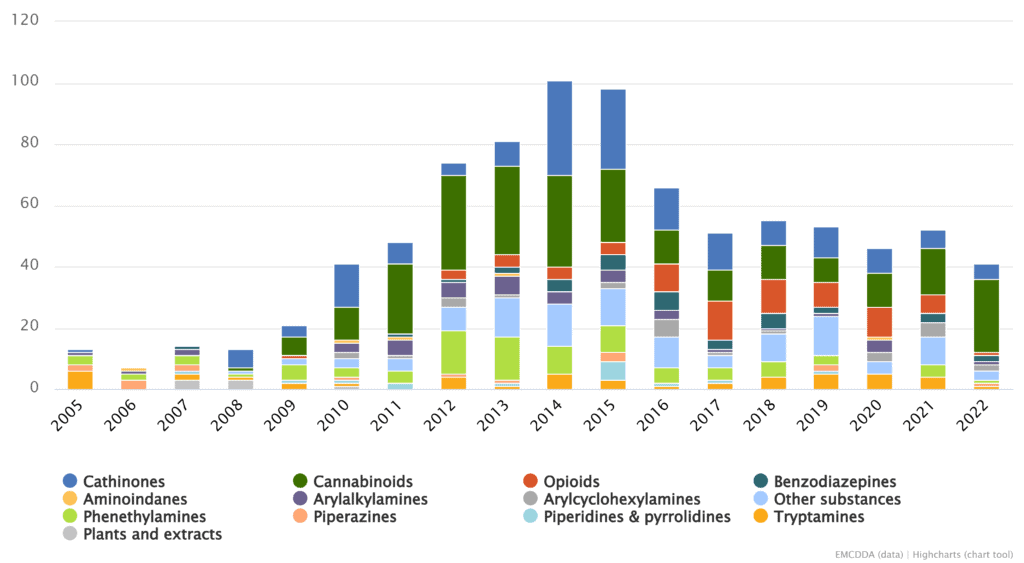
EMCDDA Director Alexis Goosdeel encapsulates the current drug situation with the phrase “Everywhere, Everything, Everyone,” highlighting the widespread accessibility of established drugs, the emergence of potent new substances, and the universal impact of drugs on society. To better understand and respond to the evolving drug situation, the report calls for improved forensic and toxicological data. It emphasizes the necessity of a European network of forensic and toxicological laboratories, which the EMCDDA will launch under its new mandate in 2024, to strengthen capacity in this field.
A comparative overview of drug statistics across European countries
Cannabis continues to be the most prevalently used illicit drug across Europe. It is estimated that 8% of European adults aged 15-64, approximately 22.6 million people, have used cannabis in the past year. The year 2021 saw a record quantity of cannabis seizures in the EU, with 816 tonnes of cannabis resin and 256 tonnes of herbal cannabis, indicating its widespread availability. Additionally, approximately 97,000 individuals sought drug treatment for cannabis-related issues in the same year. In Czechia the percentage is quite high: with 22.9% of young adults (15-34) having consumed it in 2022, compared to the Polish 7.8% or to the Hungarian 3.4%.
Figure 2. Prevalence of Cannabis use in Europe for Young Adults (15-34) in 2022
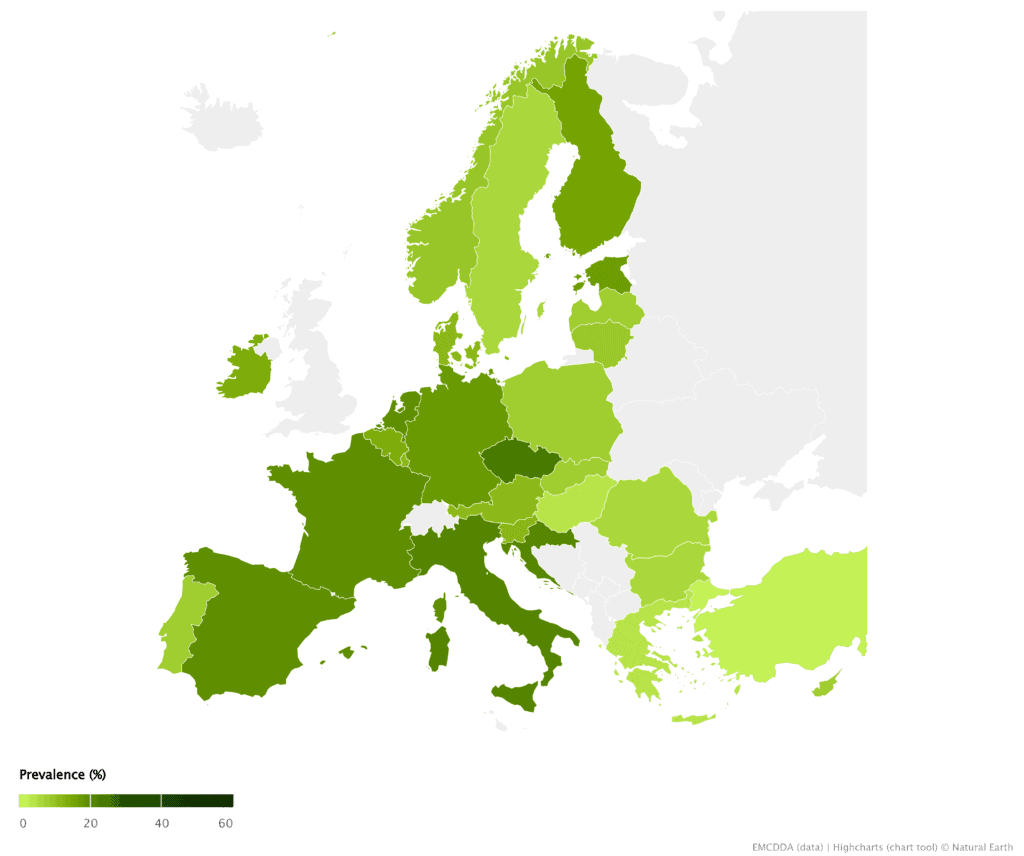
In response to changing perspectives on cannabis use, five EU Member States – Czechia, Germany, Luxembourg, Malta, and the Netherlands – along with Switzerland, are either introducing or considering regulatory frameworks for the recreational use of cannabis.[2] These initiatives aim to control its supply, with an emphasis on public health and safety. As such, there is an expressed need for enhanced monitoring and evaluation efforts to comprehensively assess the implications of these regulatory changes on public health and safety. These developments indicate a shift in policy approach towards cannabis, reflecting broader trends and debates on drug use and regulation within the European context.
Cocaine trafficking through European seaports continues to drive the drug’s high availability, leading to concerns over increased use, health harms, and drug-related crime. The report notes the rise in cocaine seizures in major European ports and the emerging trend of illicit cocaine manufacturing within the EU. The Czech Republic performs better than other countries in terms of cocaine usage, with 2.7% of adults 15 to 64 having used it at least once in a lifetime, compared to the highest Spanish data of 12%.
Figure 3. Prevalence of Cocaine use in Europe for Adults (15-64) once in a lifetime in 2022
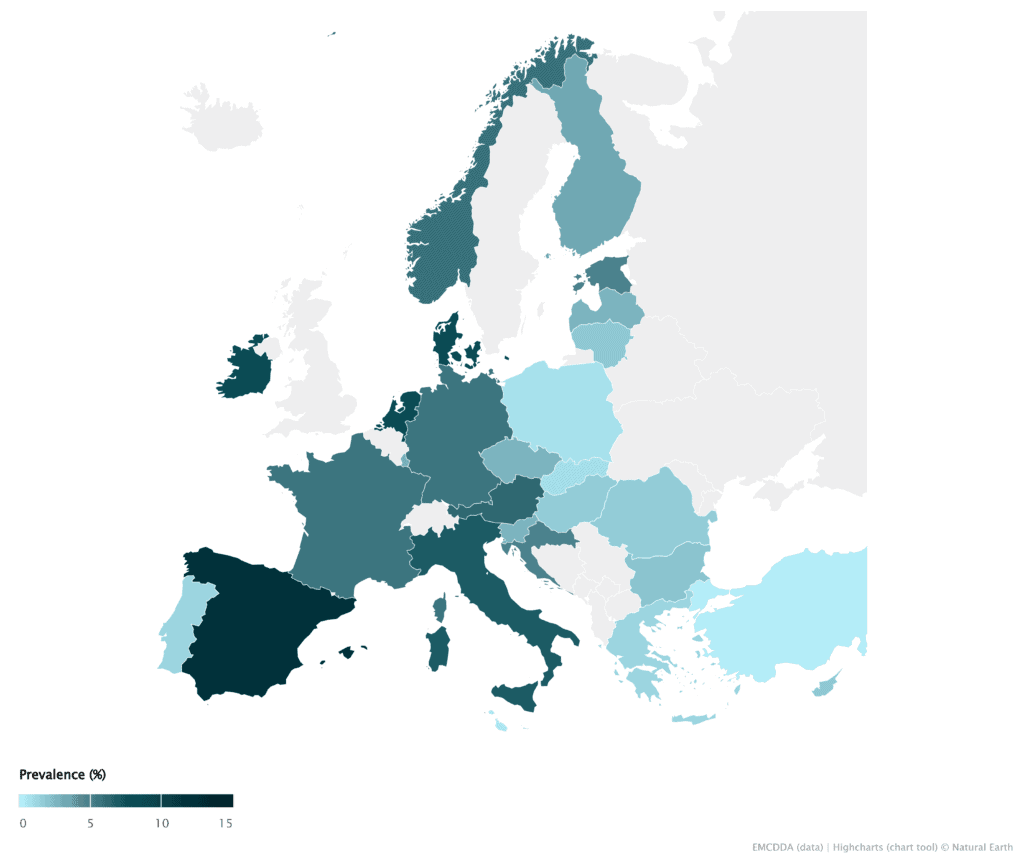
The report also highlights the increasing public health risks associated with a wider variety of synthetic stimulants, the recreational use of ketamine and nitrous oxide,[3] and the potential of psychedelic drugs. It underscores the evolving opioid problems in Europe, with heroin remaining the most commonly used illicit opioid and growing concerns about the use of highly potent synthetic opioids. The Czech Republic stands out for the comparatively high usage of MDMA, registering the highest percentage of at least once in a lifetime usage in young adults (18.6%), against the Polish 1.4% and German 8%.
Figure 4. Prevalence of MDMA (‘ecstasy’) use in Europe for Young Adults (15-34) once in a lifetime in 2022
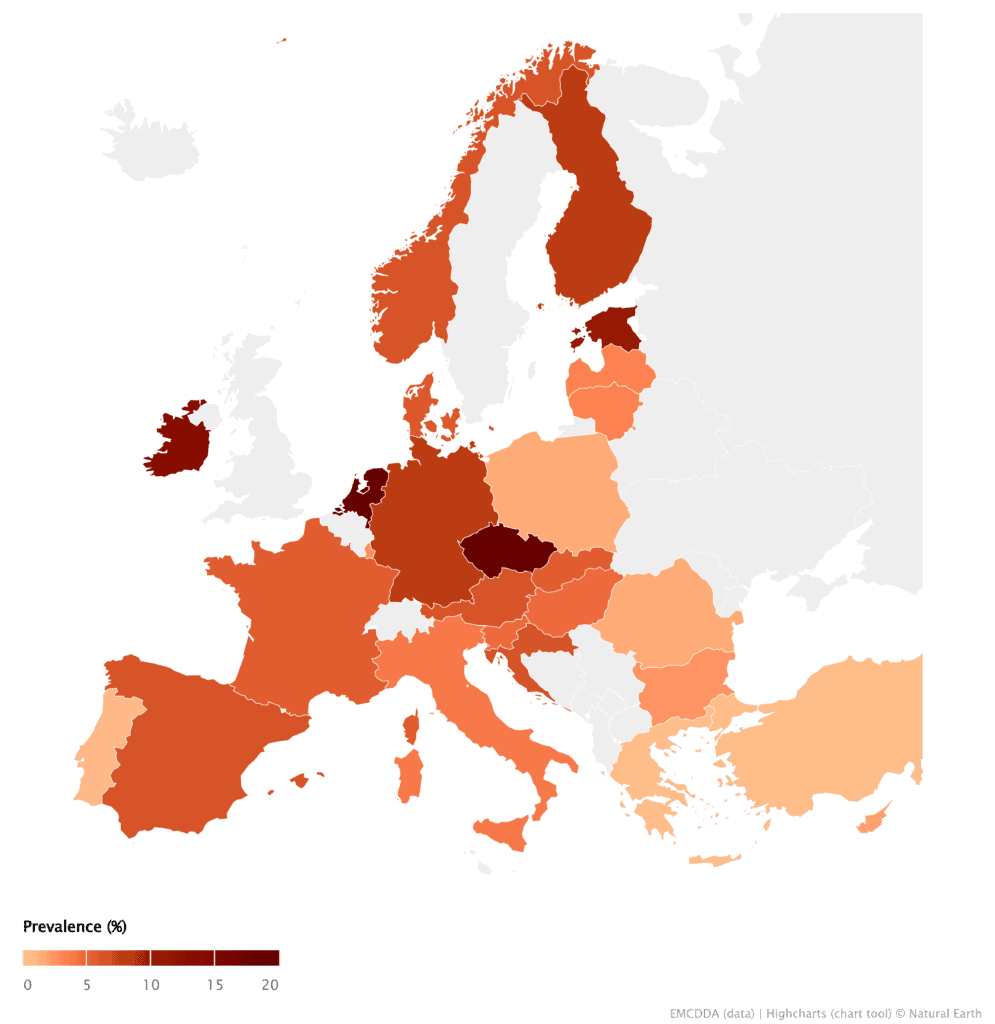
Additionally, out of 12 metropolitan cities, Prague resulted to have the highest number of used syringes tested positive for methamphetamine. However, it comparatively showed a considerably lower percentage of syringes positive for cocaine (0.7% compared to Cologne’s 57.8%) and heroin (20.3% compared to Budapest’s 40.9%).
As the EMCDDA prepares for a new mandate and expanded role,[4] the European Drug Report 2023 serves as a crucial resource for understanding the drug situation in Europe and its implications for public health and security. The agency’s future mission aims to enhance monitoring capabilities, improve EU preparedness, and develop competence for better interventions in the drugs field.
Drugs in the Czech Republic
The Czech Republic is grappling with a significant public health crisis, as drug addiction rates have soared over the past decades. According to a 1996 research of Tirlik M. et al. published by the National Library of Medicine,[5] there already had been a notable increase in illicit drug use across the nation, with amphetamines topping the list of preferred substances. Polydrug use was prevalent, and there had been a particular uptick in the use of so-called ‘dance drugs’ like lysergic acid diethylamide (LSD) among the youth, alongside heroin in urban centres. The trend towards injecting drugs was also on the rise, compounding the urgency for expanded drug treatment services.
The National Monitoring Centre for Drugs and Addictions (NMC) for the Czech Republic published in 2023 its annual report on addictive habits of the Czech population.[6] In the next sub-sections we will go through the most significant data available.
Drug usage in the adult population (including alcohol and tobacco)
In the adult population, a notable proportion engages in addictive behaviours across various substances and activities. Approximately 17-23% (1.5-2.1 million) of individuals aged 15 and older are daily smokers, while about 10% (800-980 thousand) consume alcohol daily or almost daily, with 17-19% (1.5-1.7 million) being high-risk alcohol consumers and 9-10% (800-900 thousand) categorized under harmful drinking. Psychoactive medicines pose a problem for 14-15% of adults, accounting for around 1.3-1.5 million people. Cannabis usage in the last year affects 6-10% of the population (500-900 thousand adults), with an estimated 400 thousand at risk of problem use, and 5-7% using it for self-treatment. Other illicit drug use includes 1% using ecstasy, 2% hallucinogenic mushrooms, and less than 1% each for methamphetamine and cocaine. High-risk users of methamphetamine or opioids total approximately 44.9 thousand, including subcategories of various drug users. These statistics highlight the significant public health challenges posed by various forms of addiction within the adult population, underscoring the need for comprehensive and targeted health interventions.
Drug usage in the young population (including alcohol, tobacco and digital addiction)
The prevalence of addictive behaviour among children and adolescents reveals concerning trends in substance use and digital engagement. Approximately 10-11% of 13- to 16-year-old students regularly smoke tobacco, while alcohol consumption is widespread, with 17% of 11-year-olds, 43% of 13-year-olds, 76% of 15-year-olds, and 95% of 16-year-olds having drunk alcohol at some point in their lives. More than half of these individuals have reported drinking in the last 30 days, and 39% of 16-year-olds engage in binge drinking monthly, with 12% doing so weekly or more. Illicit drug use is reported by 24% of 16-year-olds in the last 12 months, with cannabis being the most common, followed by sedatives without a prescription, volatile substances, ecstasy, hallucinogenic mushrooms, LSD or other hallucinogens, and a smaller percentage using cocaine or methamphetamine. Digital addictions are also prevalent, with 15-25% of 11-15-year-olds and 10-15% of 15-19-year-olds reporting excessive gaming. Social media use is excessive among 25-30% of children and 45-50% of adolescents, with 7% of children and up to 30% of adolescents at risk of addiction.
Social costs of drug abuse in Czechia
Substance use significantly contributes to morbidity and mortality, with tobacco smoking causing 16-18 thousand deaths annually and alcohol leading to 6-7 thousand deaths per year, including about 2 thousand cases where it’s the primary cause, with 400-500 due to alcohol intoxication. In 2021, fatal overdoses resulted in 64 deaths, predominantly from illicit drugs or volatile substances, and 10 from benzodiazepines. Additionally, 150 deaths were related to other consequences of illicit drug and psychoactive medicine use, such as illness, accidents, and suicide.
Health complications from substance use extend to infectious diseases, with 7 new HIV diagnoses in 2021 associated with injecting drug use and 800-1,100 hepatitis C cases reported annually, including 400-600 among injecting drug users. Hospital admissions for injuries under the influence of addictive substances reach 14-15 thousand yearly, mainly due to alcohol but also due to illicit drugs, psychoactive medicines, and volatile substances. Furthermore, alcohol and other drugs contribute to 4,500 and 320 traffic accidents each year, respectively.
Mental health is severely affected by problem gambling, with over 70% of at-risk individuals reporting anxiety-depressive disorders, 46% having suicidal ideations, and 14% attempting suicide. Moreover, children and adolescents at risk of digital addiction are 2-6 times more prone to neglect leisure activities, experience sleep or eating disorders, face problems at school, and see negative impacts on their social life with friends and family. These extensive impacts of substance use highlight the need for robust, multidimensional strategies to address the health, social, and psychological consequences.
Czech response to the issue
This crisis, which has been escalating over the past 50 years, shows no signs of abating, with public health measures struggling to keep pace with the growing addiction statistics and the detrimental effects of drug use on individuals, families, and communities. The path forward for the Czech Republic in mitigating this drug problem hinges on the implementation of effective and accessible drug and alcohol rehabilitation programs. It is highly important policy wise to mention that, according to the European Drug Report 2023,[7] the Czech Republic, with a similar pattern in Slovakia and Turkey, shows a prevalence of first-time treatment entrants (over 30%) for methamphetamine users.
Figure 5. Amphetamine entrants as share of all first-time treatment entrants
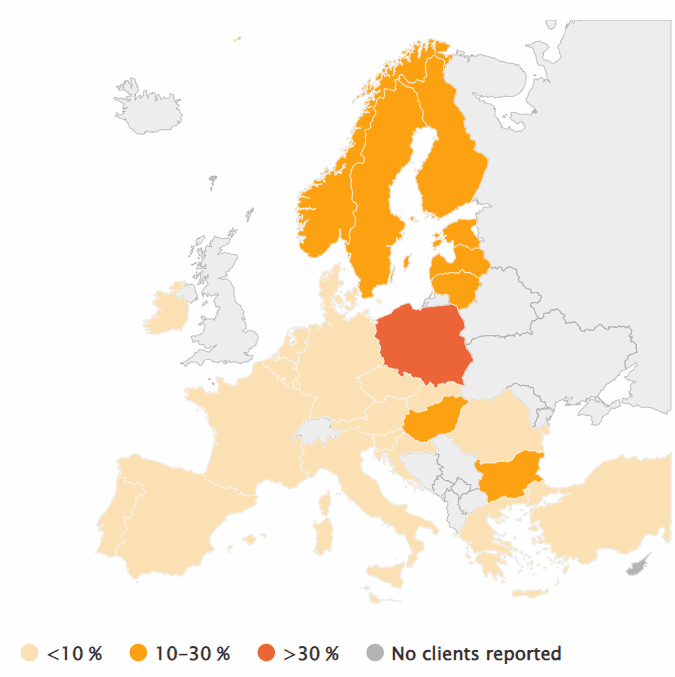
Source: European Drug Report (2023). Available at: https://www.emcdda.europa.eu/publications/european-drug-report/2023_en
In the Czech Republic, a comprehensive network of 250-300 facilities provides specialized addictology services to address substance use and related issues. This network includes 55-60 low-threshold centres, 50 outreach programs, and 90-100 outpatient treatment programs, of which 10 are dedicated to children and adolescents. Additionally, there are 10-15 detoxification units, 25-30 inpatient healthcare units, 15-20 therapeutic communities, and 35-45 outpatient aftercare programs, including 20-25 with sheltered housing. Moreover, 5-7 homes operate under a special regime for substance users. In terms of opioid substitution treatment, 60 facilities report patients in such programs, and an estimated 600-700 general practitioners provide this form of treatment.
Half of the addictology services cater to gamblers, and more than a third address individuals at risk of digital addiction. Tobacco dependence treatment is available at 43 centres located in hospital outpatient clinics, with around 200 outpatient doctors and approximately 300 specialist pharmacies offering counselling services.
Residential treatment centres are crucial in providing a structured environment where individuals can confront their addiction. These centres address both the physical aspects of dependency and the psychological drivers behind substance use. By identifying and treating the root causes of addiction, these facilities offer a holistic approach to recovery, providing individuals with the tools they need for long-term sobriety.
The Czech Republic’s challenge lies in expanding and enhancing these support systems to meet the growing need and break the cycle of addiction affecting so many of its citizens. Hopefully, with support from the renewed structure of the European Monitoring Centre for Drugs and Drug Addiction, Czechia will be able to effectively tackle this long-lasting issue.
Sources
-
https://www.emcdda.europa.eu/event/2023/06/launch-event-european-drug-report-2023_en ↑
-
https://www.emcdda.europa.eu/publications/faq/cannabis-laws-europe-questions-and-answers-for-policymaking_en ↑
-
https://www.emcdda.europa.eu/news/2022/11/no-laughing-matter-new-report-shows-rise-recreational-use-nitrous-oxide_en ↑
-
https://www.consilium.europa.eu/en/press/press-releases/2023/03/28/eu-drugs-agency-council-presidency-and-european-parliament-agree-to-strengthen-the-agency-s-role/ ↑
-
https://pubmed.ncbi.nlm.nih.gov/9839038/ ↑
-
https://www.drogy-info.cz/en/situation-reports-cz/summary-report-on-addictions-in-czechia-2022/ ↑
-
https://www.emcdda.europa.eu/event/2023/06/launch-event-european-drug-report-2023_en ↑





